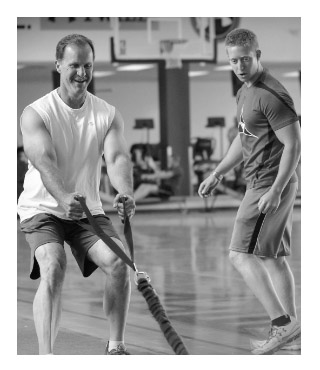Five Ways To Stay in Shape At Age 40+
April 14, 2017
If you’re over 40, can you live up to the saying: “You’re not getting older, you’re getting better!”
Can you stay in shape despite going toe to toe with an insane schedule and the aging process?
Can you avoid the pain of achy joints and the disappointment of losing muscle strength?
Consider the story I posted on Facebook a few weeks ago about Craig, project manager at an oil company who trains at my gym. Craig gets to the gym at 6:00 am damn near daily, but there’s a problem.
He does the same exercises and uses the same weight every time. There is no rhyme and no reason. And he looks the same…day after day, week after week, even year after year.
He’s annoyed by his lack of progress. He’s using the same workout routine he used when he was 25. But now his joints constantly ache. He hasn’t gotten any stronger. He doesn’t have more energy. His arms haven’t grown bigger. And most of all, he’s pissed he can’t lose his gut, pointing to that annoying lower belly fat.
The reason?
If you don’t push your body beyond what it’s currently doing, it won’t change.
Further, what worked early on in your fitness journey won’t always help you stay in shape and may actually set you back.
When I posted the story on Facebook, controversy erupted, along with some misinterpretation. (Oh, the joys of social media.) But amidst the trolling, a great question was asked.
How does “progress” change when you get older?
Whether you have decades of experience or are walking into the gym for the first time, here are specific ways you can train smart and make progress well past the age of 40.
P.S. Are you looking for a simple, joint friendly workout to help you build muscle without living in the gym? Join the Minimalist Muscle Movement Today.
Determine Your Goal
What is progress to you? Different goals require different plans of action and levels of determination. Consider the following.
You Want to Gain Muscle or Minimize the Loss of Lean Muscle
Maintaining lean muscle mass and strength is progress in and of itself. This study suggests untrained people will start losing strength and muscle at age 30. Yikes.
If you’re in your 30’s and not exercising, now is the time to start. You can delay the bad stuff. Those who already train, like my client Tim, can take their fitness step further stay jacked.
Here’s a picture of Tim and me training nearly six years ago. Today? Well, he still has bigger biceps than I do. Damn it.
The benefits of gaining lean muscle:
- The more lean muscle you have, the more muscle glycogen your muscles will store. Besides keeping your muscles looking full, increasing glycogen storage in your muscles creates a “dietary buffer” that allows for more flexible food choices. Hello, steak and potatoes.
- Lean muscle mass improves insulin sensitivity. This means you’ll break down the food you eat more efficiently to fuel muscle growth and provide energy and store less fat. You’ll also decrease your risk of cardiovascular disease and diabetes.
- It helps you look pretty fucking awesome. You don’t want to develop the dreaded grandpa butt, right? Muscle will keep you strong, athletic, and capable of handling yourself in the gym and out in the world.
- Muscle is metabolically “expensive,” meaning it takes more energy to maintain lean muscle mass than fat mass. This supports a healthy metabolism and makes it easier to stay lean.
- When you lose body fat, muscle provides the “tone” shape, and/or definition you crave. Dieting only takes you so far. You need a base of lean muscle to get the look you’re after.
What About Getting Stronger?
Getting strong is a great way to stave off muscle loss and improve everyday function and energy. Regardless of your age, the rules of progressive overload always apply. To build muscle and strength in the gym you’ll need to do more than your body is accustomed too.
But don’t limit your options to heavier weights or more reps. Maintaining your strength but improving range of motion, technique, or using a slower tempo is overload, after all.
Here’s why maintaining or even improving your strength is so important:
- Strength makes everything else easier, meaning you’ll have more functional capacity to do everyday activities.
- Strength increases muscle fiber recruitment. Building (or even maintaining) strength helps you maintain muscle fiber function, particularly type 2 muscle fibers. This helps you maintain athleticism. On the other side, type 2 muscle fibers, the fast twitch ones, can help prevent falls as you reach the twilight years.
- Strength training can reduce bone loss (osteoporosis) and muscle loss, atrophy. In both cases, you’ll gain the strength and structure to perform regular activities with ease.
It’s clear lean muscle and strength play an important role in helping you maintain a high quality of life as you age. But here’s the deal: A 55-year-old lifter probably can’t do the same stuff as the 25-year-old hot shot at the gym.
How Does Making Progress Change?
If you’re new to training. You’ll be able to build lean muscle and strength by weight training 2-3x per week. You’ll make gains right away by improving your central nervous system (CNS) function as your body learns to activate more muscle fibers and improve coordination between muscles and movements. We call this neural adaptation. Further along down the road, eating a diet to support building lean muscle will help. Don’t expect to build tons of muscle if you’re older. But remember: even a slight increase or maintenance over time is extremely beneficial.
If you’re an experienced lifter. Yes, you can still make gains. But chances are your body won’t take kindly to chasing strength records as your only means of making progress. Look for other methods to create progressive overload.
- Slow down your tempo. This creates more time under tension, which helps you build lean muscle and do more work with less total weight.
- Add pauses during your reps. This builds strength in common weak points and increases time under tension. Together, this can drive gains in strength and muscle.
- Increase your range of motion. More range of motion will hit a greater number of muscle fibers. Make sure your form is tip-top.
- Decrease rest periods to increase the cardiovascular and metabolic demand of your training. Always good to lose the spare tire, right?
- Give timed sets a whirl. Your body doesn’t know reps or weight, it knows tension and time. Battle the clock, like performing a set of goblet squats for 45 seconds, instead of chasing rep or resistance based- records.
Putting It All Together
Lift weights two or three times per week to get stronger. Keep your focus on the bread and butter lifts of all good programs: Squats, hinges, rows, presses, lunges, and carries. Don’t be obsessed with setting a PR or stick to barbells as your only training tool. Use whatever tools allow for pain-free training, bump the reps up a little bit, and get after it. Done right, you’ll improve muscle fiber recruitment and stave off sarcopenia, the dreaded “
Done right, you’ll improve muscle fiber recruitment and stave off sarcopenia, the dreaded “age-related muscle loss” that drains your performance, physique, and strength.
Add movements like skipping, light rope-jumping, cariocas, and other athletic-based movements to improve your balance, coordination, and athleticism. Learning (or relearning) new skills is great for both mind and body.
Challenging your body keeps neural pathways fresh for better physical and cognitive function. As a bonus, many of my clients have said this is a fun change of pace.
Five Tips for Training Smarter
1. There are NO absolutes.
No, you don’t need to do a barbell back squat. Or a deadlift. Or (for the love of god) Bosu ball jump squats. In the gym, there are no absolutes. Don’t fall prey to the dogmatic folks who say, “you need to do this” or nothing works.
Here are a few common sense rules to keep you in the right direction.
(1) If something hurts, don’t do it.
(2) Move your body in multiple ways. Push, pull, squat, hinge, and carry stuff.
(3) Don’t fall in love with one tool. Use your bodyweight, dumbbells, kettlebells, or whatever you have around you. See what forces you to work hard without breaking you down.
2. Warm Up Every Day
Most people spend their days hunched over computers and phones. Over time, that takes its toll. The bad posture gets hardwired into your system and becomes the new “natural.”
Take time each day to move in new ways. It doesn’t have to be fancy, but stay active.
Use the mobility drills and activation outlined here to increase your mobility, reduce pain, and improve posture.
This is the exact warm-up my clients follow day in and day out.
3. Reduce Axial Loading
Axial loading, known as loading from the top-down in the lifting world, is done via exercises like back squats, cleans, and military presses. In small doses, axial loaded exercises are great. They’re the big compound movements. They improve bone density, total body strength, muscle mass, and are important for building a strong, athletic body.
But you must do them sparingly. The older you become, the less tolerant you’ll be too heavy and explosive exercises. Your spine won’t tolerate heavy compressive load from heavy weights or shear stress.
These exercises aren’t bad. They’re only problematic when they’re poorly planned, don’t allow enough recovery, and irritate chronic injuries like a twinge knee or achy back.
If you’re going to do squats, presses, and deadlifts, cool. They’re great exercises. But pay close attention to how your body recovers.
4. Make Heavy Days Lighter and Less Frequent
The biggest difference between now and ten years from now will be how often you’re able to lift heavy.
While heavy one-five rep sets are great for building strength, more experienced lifters will have a much harder time recovering from heavier weights. Instead of always blitzing the 1-5 rep range, bump strength work to 4-8 reps, control the eccentric (way down) and accelerate every rep on the way up.
If my clients want to push strength numbers in these lifts, We keep “heavy” sets in the 4-8 rep range rather than 1-5 rep sets. Further, we ramp up to heavy 5-8 rep maxes every 4-6 weeks, not weekly.
Feel free to lift heavy regardless of your age, but pay close attention to how your body tolerates the stress. Consider a deloading from axial loaded exercises like squats and deadlifts every 8-10 weeks to give your body a break.
Once you have a significant base of strength, you’ll preserve most of your strength and might even build more muscle in this rep range, all while preserving your joints for the long haul.
5. Find the Routine You Will Do, No Matter The Circumstances
Training four or five times per week with strength work, mobility, and conditioning is great. But sometimes it’s impossible to do everything when you have work obligations, kids, school, and dozens of commitments.
Instead of skipping the gym when life gets crazy, understand what you’re capable of doing consistently and schedule training like a non-negotiable meeting. If you skip make the gym, perform this short routine every morning when you get up.
Set a timer for ten minutes and do this:
– Push Up x10
– Squat x10
– Inchworm x5
– Groiner with T-Rotation x1/side
– Side lunge x5/side
This takes just ten minutes each day. That’s it.
Remember, half the battle is getting there. Sometimes it’s okay to maintain. When the chance arises, increase your focus and intensity.
In the greater scheme of fitness, an imperfect fitness routine performed consistently will win out over the “perfect” program done sporadically.
Go Forth and Stay in Shape, And Live Well
Growing older is part of life. The pursuit of a healthy, strong, and energetic body is about pushing past your comfort zones and getting a little bit better over time.
But there are many ways to accomplish your goals.
Don’t fall for the trap that you “must do” any one thing. The only absolute in training is there are none.
Instead, find what you enjoy and do it consistently.
Even more important, find out what agrees with your body and keep doing it. If exercises are making you hate the gym or causing old pains to creep back in, take them out and find the cause.
The real goal of the gym is to challenge yourself and take action to conquer what was previously deemed unconquerable.
The payoff is a happier, healthier and longer life. And big biceps. 😉
P.S. Are you looking for a simple, joint friendly workout to help you build muscle without living in the gym? Join the Minimalist Muscle Movement Today.












One of the best articles I’ve read for people of my age (45). I’ve discovered/started ‘proper’ strength training in the last 18 – 24 months rather than effectively wasting time at gyms achieving effectively nothing and has just about changed my life. I looked and felt better on my 45th birthday than I did at 40 (apologies for self congratulation). This page sums up in 1 article what has taken me along time to learn. If only I’d seen this 5 or even10 years ago.
Thank you, Andy. I appreciate it! Glad to hear you’re training is improving. Is there anything I didn’t cover that you’d add?
You just about covered it.
I would say volume is a killer as you get older. I see volume as Volume = Exercise Intensity x Exercise Frequency. So I found for example I continued to get stronger using a M W F M Th regime and keep gaining. I struggled to train well during the week if I went out and Mountain Biked heavily at a weekend.
Also keeping a written record of work done and how it felt made all the difference. I learnt to spot when I was about to over do it so could ease back on the next session.
Finally you have to fuel muscle growth with food – preferably protein.
Great article! I especially like the sections on strength training and mobility. Strength training is IMO the Fountain of Youth. Mobility is key to staying injury free. Reducing injuries is key to continuing to train and make gains as we age.
I completely agree, Bob. Thanks for reading!
Great article I’m 49 so this will help alot
Thank you, Eddie. Happy to help.
Really like the article, Eric. I’m 70, still play basketball and constantly looking for new ways to stay competitive and in shape. Am coming to the realization that more is not necessarily better. Rest is so important and pushing myself is good but don’t go crazy. I have learned a lot from your article and will adjust my workouts to reflect your valuable information. Thanks.
Thank you, Garry! Great to hear you’re still playing basketball and getting after it.
Terrific article. Hitting 60 next year like a sledgehammer.. Lol pr on bench last week of 280..body weight 195. Goal is a pr over 300 on the 60th. Had to ease up on the squats, the knees aren’t happy.. Other than that all good. Lifting lets us get older without getting old..
Thank you, Al. I love your saying, “lifting lets us get older without getting old.” Congrats on the PR.
Love this article Eric, so informative and it all makes perfect sense. I feel like I have lost my way in my own training but your article really helped me to refocus on what’s important. For me it’s going back to the core lifts and movement patterns while focusing on perfect form plus TUT. For the next 8-12 weeks that will be my main focus and not SO much about the weight. The mobility drill videos are super helpful as well.